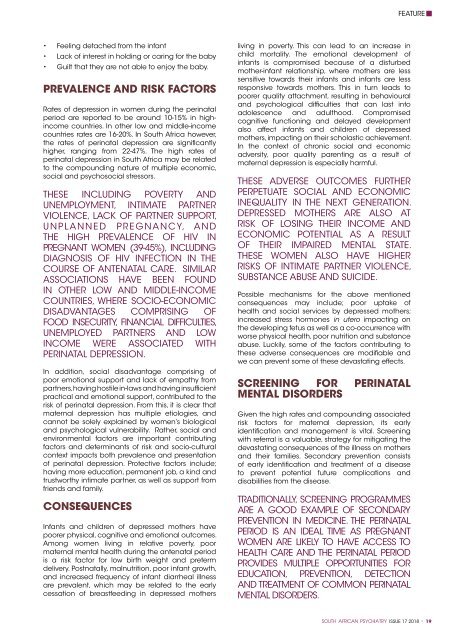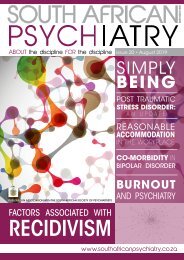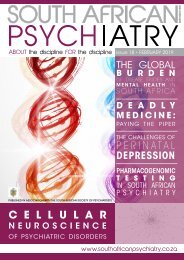South African Psychiatry - November 2018
South African Psychiatry - November 2018
South African Psychiatry - November 2018
You also want an ePaper? Increase the reach of your titles
YUMPU automatically turns print PDFs into web optimized ePapers that Google loves.
FEATURE<br />
• Feeling detached from the infant<br />
• Lack of interest in holding or caring for the baby<br />
• Guilt that they are not able to enjoy the baby.<br />
PREVALENCE AND RISK FACTORS<br />
Rates of depression in women during the perinatal<br />
period are reported to be around 10-15% in highincome<br />
countries. In other low and middle-income<br />
countries rates are 16-20%. In <strong>South</strong> Africa however,<br />
the rates of perinatal depression are significantly<br />
higher, ranging from 22-47%. The high rates of<br />
perinatal depression in <strong>South</strong> Africa may be related<br />
to the compounding nature of multiple economic,<br />
social and psychosocial stressors.<br />
THESE INCLUDING POVERTY AND<br />
UNEMPLOYMENT, INTIMATE PARTNER<br />
VIOLENCE, LACK OF PARTNER SUPPORT,<br />
UNPLANNED PREGNANCY, AND<br />
THE HIGH PREVALENCE OF HIV IN<br />
PREGNANT WOMEN (39-45%), INCLUDING<br />
DIAGNOSIS OF HIV INFECTION IN THE<br />
COURSE OF ANTENATAL CARE. SIMILAR<br />
ASSOCIATIONS HAVE BEEN FOUND<br />
IN OTHER LOW AND MIDDLE-INCOME<br />
COUNTRIES, WHERE SOCIO-ECONOMIC<br />
DISADVANTAGES COMPRISING OF<br />
FOOD INSECURITY, FINANCIAL DIFFICULTIES,<br />
UNEMPLOYED PARTNERS AND LOW<br />
INCOME WERE ASSOCIATED WITH<br />
PERINATAL DEPRESSION.<br />
In addition, social disadvantage comprising of<br />
poor emotional support and lack of empathy from<br />
partners, having hostile in-laws and having insufficient<br />
practical and emotional support, contributed to the<br />
risk of perinatal depression. From this, it is clear that<br />
maternal depression has multiple etiologies, and<br />
cannot be solely explained by women’s biological<br />
and psychological vulnerability. Rather, social and<br />
environmental factors are important contributing<br />
factors and determinants of risk and socio-cultural<br />
context impacts both prevalence and presentation<br />
of perinatal depression. Protective factors include;<br />
having more education, permanent job, a kind and<br />
trustworthy intimate partner, as well as support from<br />
friends and family.<br />
CONSEQUENCES<br />
Infants and children of depressed mothers have<br />
poorer physical, cognitive and emotional outcomes.<br />
Among women living in relative poverty, poor<br />
maternal mental health during the antenatal period<br />
is a risk factor for low birth weight and preterm<br />
delivery. Postnatally, malnutrition, poor infant growth,<br />
and increased frequency of infant diarrheal illness<br />
are prevalent, which may be related to the early<br />
cessation of breastfeeding in depressed mothers<br />
living in poverty. This can lead to an increase in<br />
child mortality. The emotional development of<br />
infants is compromised because of a disturbed<br />
mother-infant relationship, where mothers are less<br />
sensitive towards their infants and infants are less<br />
responsive towards mothers. This in turn leads to<br />
poorer quality attachment, resulting in behavioural<br />
and psychological difficulties that can last into<br />
adolescence and adulthood. Compromised<br />
cognitive functioning and delayed development<br />
also affect infants and children of depressed<br />
mothers, impacting on their scholastic achievement.<br />
In the context of chronic social and economic<br />
adversity, poor quality parenting as a result of<br />
maternal depression is especially harmful.<br />
THESE ADVERSE OUTCOMES FURTHER<br />
PERPETUATE SOCIAL AND ECONOMIC<br />
INEQUALITY IN THE NEXT GENERATION.<br />
DEPRESSED MOTHERS ARE ALSO AT<br />
RISK OF LOSING THEIR INCOME AND<br />
ECONOMIC POTENTIAL AS A RESULT<br />
OF THEIR IMPAIRED MENTAL STATE.<br />
THESE WOMEN ALSO HAVE HIGHER<br />
RISKS OF INTIMATE PARTNER VIOLENCE,<br />
SUBSTANCE ABUSE AND SUICIDE.<br />
Possible mechanisms for the above mentioned<br />
consequences may include; poor uptake of<br />
health and social services by depressed mothers;<br />
increased stress hormones in utero impacting on<br />
the developing fetus as well as a co-occurrence with<br />
worse physical health, poor nutrition and substance<br />
abuse. Luckily, some of the factors contributing to<br />
these adverse consequences are modifiable and<br />
we can prevent some of these devastating effects.<br />
SCREENING FOR PERINATAL<br />
MENTAL DISORDERS<br />
Given the high rates and compounding associated<br />
risk factors for maternal depression, its early<br />
identification and management is vital. Screening<br />
with referral is a valuable, strategy for mitigating the<br />
devastating consequences of the illness on mothers<br />
and their families. Secondary prevention consists<br />
of early identification and treatment of a disease<br />
to prevent potential future complications and<br />
disabilities from the disease.<br />
TRADITIONALLY, SCREENING PROGRAMMES<br />
ARE A GOOD EXAMPLE OF SECONDARY<br />
PREVENTION IN MEDICINE. THE PERINATAL<br />
PERIOD IS AN IDEAL TIME AS PREGNANT<br />
WOMEN ARE LIKELY TO HAVE ACCESS TO<br />
HEALTH CARE AND THE PERINATAL PERIOD<br />
PROVIDES MULTIPLE OPPORTUNITIES FOR<br />
EDUCATION, PREVENTION, DETECTION<br />
AND TREATMENT OF COMMON PERINATAL<br />
MENTAL DISORDERS.<br />
SOUTH AFRICAN PSYCHIATRY ISSUE 17 <strong>2018</strong> * 19

















